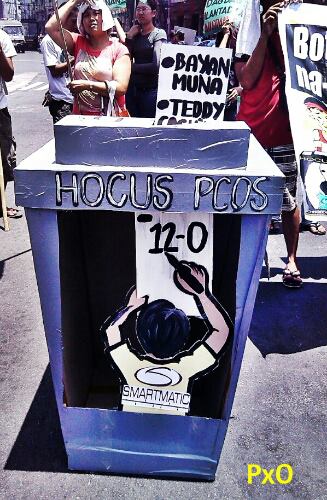In spite of claims by the Philippine Commission on Elections (Comelec) of a peaceful, orderly, and ultimately successful elections last May 13, 2013, poll watchdogs, civil society groups, IT experts, and netizens are alleging that the midterm polls were tainted by automated fraud, massive vote buying, electoral violence, and other various irregularities.
The 2013 mid-term automated elections has been declared by independent poll watch groups as a “technological and political disaster”:
Like in the 2010 presidential elections, the recently concluded polls used an automated election system (AES) which supplanted the manual system used in the 2007 polls and preceding years. The AES involves the use of a Precinct Counting Optical Scan or PCOS machine which records, counts, and transmits votes to a central server for canvassing and consolidation.In 2010, a significant number of clustered precincts in both provinces and cities had delayed transmissions of up to two days; as of May 17 or four days after this year’s election, 18,187 clustered precincts or 23% of the total number failed to transmit election returns affecting if not potentially disenfranchising 8.6M voters.
The AES Watch said that most of the election problems that it monitored were PCOS-related. This includes initialization errors, machine breakdown to hardware problems, ballot rejection by the machine, and transmission problems from the machine to the canvassing centers and Comelec servers.
This comes alongside observations of an improbable “pattern” of the votes obtained by senatorial candidates during the elections wherein those coming from the administration party consistently got 60 percent, the ones from the Opposition United Nationalist Alliance got 30 percent, and the independents got 10 percent of the votes.
Sorting through the tallies of the senatorial race from the first to the 16th canvass reports, Ateneo University professor Lex Muga noted the peculiar pattern. Using the election data released from the news website Rappler.com, the blog Radar Sweep meanwhile discovered the same pattern in all 11 intervals checked.
“Hacking Our Democracy” author Prof. Rene Azurin warned that the uniformity of the senatorial race results wherein no ranking changes occurred from the beginning to every lull in the counting pointed to the pre-programming of the automated system in order to ensure a 9-3 victory for the ruling party. Azurin cites former Comelec IT director Ernie del Rosario who said:
The progressive tallies follow some sort of deterministic linear equation devoid of the influence of any probabilistic parameter or variable. This can only mean one thing — it is a pre-designed results reporting mechanism that fits the 9-3 survey instead of a tally of the actual votes. I will call it the 9-3 Formula. Notice that the rankings of the candidates in the entire tally (1st to 33rd place) from the time the first report was published to subsequent ones are practically unchanged. What happened to the individual candidates’ known bailiwicks that should have caused some ranking movements in the tallied results? Smoothened by the 9-3 linear formula?
In a Facebook post, Center for People Empowerment in Governance IT consultant Pablo Manalastas comments:
The correct test to determine a “conspiracy” is NOT to check the national averages to see how close to 60-30-10 we can get, because this is exactly what the law of large numbers tells us that we will get. The more correct indicator of a conspiracy is if we get the same 60-30-10 figures in a precinct-by-precinct comparison, provided that the precinct figures were used to get the national canvass.
Meanwhile, Rick Bahague of the Computer Professionals Union also shared graphs showing the same disturbing pattern in all 18 towns of Bohol Province on Facebook.
Boholanos seem to have been genetically modified. They voted the same. The rank of the senators is almost the same in all the towns.
These fears of automated fraud is aggravated by the Comelec's lack of transparency in the conduct of the automated polls, as pointed out by Kontra Daya:
The Comelec failed to implement the basic security safeguards mandated under R.A. 9369 or the Poll Automation Law, particularly the review of the PCOS source code by political parties and citizen’s groups prior to the elections… The so-called PCOS “source code review” that was supposedly started days before the polls was worthless in terms of ensuring the integrity of the machines. It was nothing but a publicity stunt by Comelec chair Sixto Brillantes Jr. in a vain attempt to silence critics.
An hour after the voting ended last elections, the Parish Pastoral Council for Responsible Voting (PPCRV) which is the official citizen arm of the Comelec announced the partial and unofficial results from 1,418 precincts wherein more than 10 million of the votes were obtained by administration senatorial candidate Grace Poe.
When independent poll watchdogs pointed out that the figure was bloated, the PPCRV reportedly had Smartmatic change the script of the source code saying the data was incorrectly formatted and double counted.
The error is significant, as a maximum of 1,000 voters per precinct should only yield a total of around 1,418,000 maximum votes… That Smartmatic can change the script of the source code during the canvassing shows serious problems with the entire automated system.
Dr. Carol Araullo questions why a foreign corporation is allowed to control the country's elections.
More pernicious and fatal to our democratic processes, or the appearance thereof, is the virtual enthronement, if the Commission on Elections is to have its way, of the current automated election system designed and operationalized by a foreign multinational company, SMARTMATIC, to a seat of honor in running and controlling Philippine elections.
The Comelec's all too hasty proclamation of the first six winning senatorial candidates based only on 23 percent of 301 Certificates of Canvass also did not help win the confidence of the public.
In response to accusations, Comelec Chairperson Sixto Brillantes questioned the motives of those questioning the conduct of the polls and accused them of engaging in a “conspiracy”. He warned them to shut up or face legal charges. Various groups are calling for a manual recount as the only way to ensure the validity of the election results.








8 comments
Perchance, immaturity creates distrust…..
To those conspiracy theorists:
There may be a pattern in the percentage and its not 60-30-10 but if you will look closely at the names you will see that they are different winning candidates per Region.
CLEARLY NO CHEATING HERE!
To those conspiracy theorists:
There may be a pattern in the percentage and its not 60-30-10 but if you will look closely at the names you will see that they are different winning candidates per Region.
CLEARLY NO CHEATING HERE!
This what you call tainted and fraudulent election is baseless. Yes, there are hickups, but it does not necessary mean its tainted. The losers always prey on the winners. Its been over a week and this mongoloids still on the air doing nothing but bull. Get a life, work and serve the public. You are all pathetic losers.